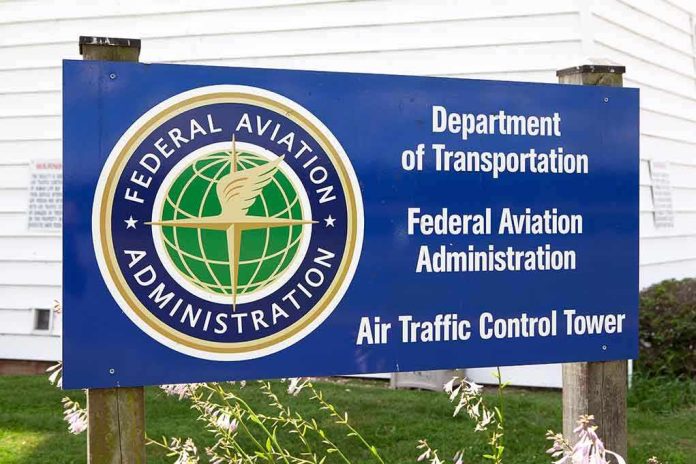
America stands on the brink of a travel catastrophe—if Congress doesn’t act, parts of the sky will go dark and air travel may descend into chaos, threatening not just vacations but the very arteries of our economy.
Story Snapshot
- Transportation Secretary Sean Duffy warns that key U.S. airspace could close if the government shutdown continues.
- A 10% reduction in airspace capacity at 40 major sites will begin November 7, 2025.
- Staffing shortages at the FAA are causing widespread flight delays and cancellations.
- This marks the longest federal shutdown in U.S. history and the first time airspace closure is publicly threatened over political gridlock.
Government Shutdown Threatens Nation’s Skies
Federal gridlock reached a boiling point on November 5, 2025, when Sean Duffy, the U.S. Transportation Secretary, sounded the alarm about an unprecedented threat: the shutdown’s ripple effect through the Federal Aviation Administration would force a 10% reduction in airspace capacity at 40 major airports beginning November 7. Duffy’s blunt warning—“You will see mass chaos”—was not just hyperbole but a direct reflection of the mounting crisis among air traffic controllers, who have been working without pay since October 1.
Staffing shortages are not theoretical. As of October 31, the FAA reported nearly half of the nation’s busiest airports were dangerously understaffed, with over 6,200 flights delayed and 500 canceled in a single day. Essential personnel, from air traffic controllers to TSA officers, have faced increasing burnout, absenteeism, and attrition as the shutdown stretches past 36 days—now the longest in U.S. history. Unlike previous shutdowns, the threat of actual airspace closures looms, with the DOT and FAA forced to weigh drastic measures if Congressional deadlock continues.
Critical Infrastructure Held Hostage by Political Gridlock
Budget disputes in Congress may sound routine, but the impact on the aviation sector is anything but. The U.S. airspace system depends on seamless coordination and robust staffing—a delicate balance now disrupted. The shutdown’s origins lie in a bitter impasse over federal appropriations, but its consequences extend far beyond Capitol Hill. Airlines, travelers, and workers alike face mounting uncertainty, financial losses, and potential safety risks.
Essential federal employees are required to keep working, but without paychecks morale has plummeted. Absenteeism is rising as bills go unpaid and fatigue sets in. Unions and industry groups have warned for years about the dangers of protracted shutdowns, but never has a Transportation Secretary publicly threatened airspace closure. The DOT and FAA find themselves with little leverage, dependent on Congressional action to restore funding and avert disaster.
Economic Fallout and Social Strain
Flight delays and cancellations have immediate financial consequences for airlines, workers, and the broader economy. Billions in economic activity are at stake, from business travel to tourism, logistics, and supply chain operations. For aviation workers and their families, unpaid labor has become a source of acute stress, raising concerns about safety and psychological well-being. The prospect of closed airspace threatens not just travel plans but the movement of goods and people across the continent.
Public trust in America’s aviation system is eroding. If the shutdown continues, Duffy’s warnings could become reality, with cascading delays, lost revenue, and long-term damage to the industry’s reputation. Political fallout may be severe, as voters assign blame to elected officials unable to resolve the impasse. Some industry leaders support Duffy’s tough stance, arguing that only dramatic action will spur Congress to act. Others worry that public warnings may deepen uncertainty and undermine confidence in air travel.
Calls for Reform and Lasting Change
The crisis exposes vulnerabilities in federal infrastructure management that demand attention. Labor economists point to the financial and psychological toll on essential workers. Policy experts argue for reforms that insulate critical sectors from political brinkmanship—no American should fear that a budget dispute could literally ground the nation. Duffy’s threat to close portions of U.S. airspace may be the wakeup call needed to rethink federal shutdown protocols and safeguard the aviation system for future generations.
As the restrictions take effect and the shutdown drags on, the world watches for a resolution. Whether Congress acts in time or the skies begin to close, this episode serves as a stark reminder: the stability of America’s infrastructure cannot be taken for granted, and the price of political gridlock may be paid in chaos above our heads.
Sources:
Fox Business: Duffy announces airspace restrictions amid government shutdown
AIN Online: Duffy Presses on ATC Delay, Closure Warnings



